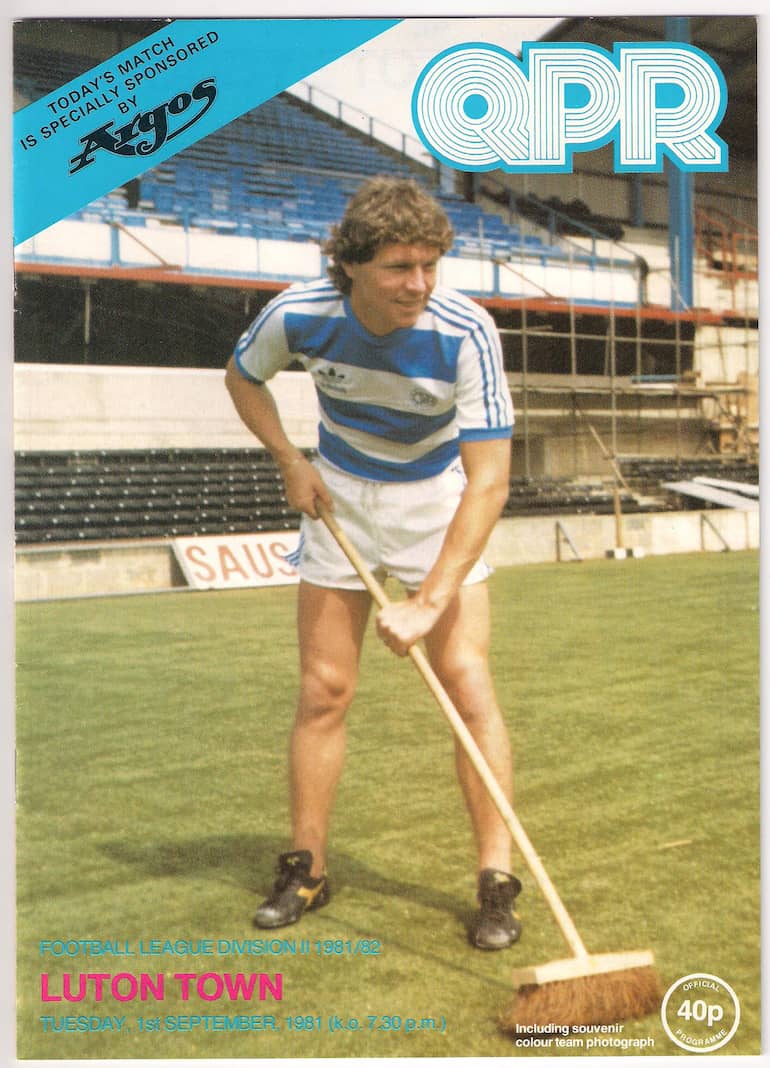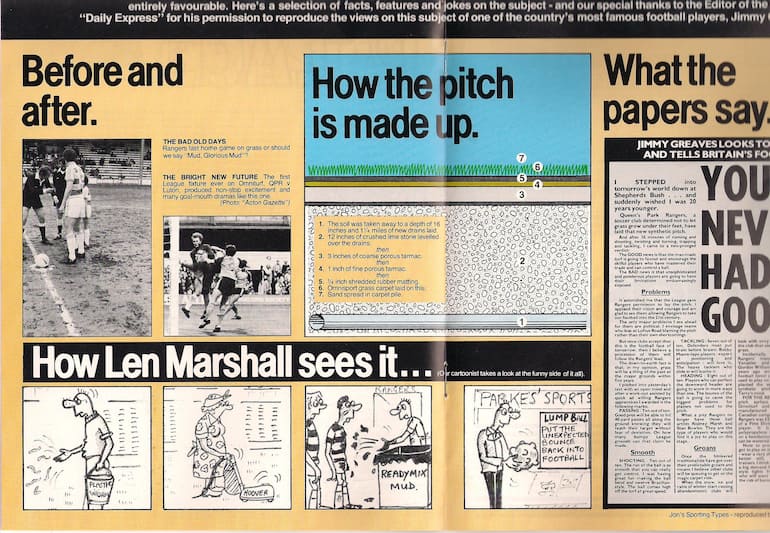IT is exactly 42 years ago this week since I attended an incredibly historic event whereby Loftus Road famously became the first League ground in Europe to stage football on plastic grass….
QUEENS PARK RANGERS 1, LUTON TOWN 2
Tuesday 1st September 1981, Football League Division Two
In his ‘Bush Telegraph’ programme editorial notes, QPR secretary Ron Phillips set the scene by writing:
“You are present when the first-ever Football League game takes place on an artificial playing surface – Omniturf, a name you’ll be hearing a lot about from now onwards.
“We predict that Omniturf will drastically change – for the better – the manner in which the nation’s clubs use their stadiums. However it does not necessarily follow that it will also change the way in which teams play soccer.’
“We have no doubt that losing teams will leave this stadium this season blaming their misfortune solely on our new pitch…we shall listen more closely to those teams who examine their results here from the point of their own players’ abilities and efforts.
“For the record, Rangers have played one or two practice games on Omniturf before this evening and the general verdict is the surface produces a fast and highly entertaining match which can only delight all spectators who watch it. We expect thrills galore at Rangers Stadium this season!’

Elsewhere in the programme, the ‘Michael Wale Report’ also concentrated on the new playing surface: “Tomorrow’s match reports, I guarantee, will be saying as much about the pitch as the game. Losing managers, no doubt, will blame it and if they are so lucky to win no doubt they will praise it.
“Rangers have taken a gigantic gamble, for which chairman Jim Gregory should be applauded. Personally I believe we will be the first of many clubs switching to this or other all-weather surfaces.’
QPR lost this momentous fixture 2-1 before a sell-out crowd of 18,703. Midfield man Andy King gave Rangers the lead via a close range strike at the School End after 35 minutes. But back came Luton in the second half with goals from Mark Aizlewood (71 minutes) and man of the match Ricky Hill (84 minutes).
At the end of the game, I wanted to take a closer look at the glistening plastic carpet in front of me. So I started climbing over the perimeter barrier for a cheeky inspection of my own.
I only jumped down about three feet on to the side of the pitch. But I nearly broke my ankle when I landed as the surface was so hard!
Anyway, the press box was packed that evening and newspaper reports the following morning made fascinating reading:
‘THE PIONEERS of 21st-century football hardly knew whether to laugh or cry last night as Luton proved the absolutely fair and exciting potential of the League’s first artificial pitch. Almost all the doubts about QPR’s synthetic surface were dispelled by a defeat which puts them firmly behind Luton as candidates for the First Division.’ (Daily Mail)
‘ARTIFICIAL pitches can jet English soccer into a glorious space-age. QPR and Luton underlined that last night when they displayed a high degree of pride, passion and pace on Rangers’ new £300,000 Omniturf pitch at Loftus Road.’ (Daily Express)
‘IF you thought soccer was a kick in the grass, - you’ll reckon it’s fantastic on plastic! That’s my verdict after League football stepped into the 21st century when Q.P.R. staged the first-ever League match on artificial grass. As a Second Division game against promotion rivals Luton, it was not so remarkable. But as a milestone in British soccer history, it was probably the most important this century.’ (The Star)
‘There is no unfair advantage to Rangers in the Second Division this season. Football, as we know it, is safe on the six-figure investment. A real magic carpet for everybody!’ (The Sun)

Terry Venables was manager of Queens Park Rangers back in 1981. He played a big part as the R’s made international headlines.
Looking back in later years, Venables said: “My chairman Jim Gregory had always been worried about the terrible problems we had with the pitch. We couldn’t get the drainage right. Even on a fairly nice day, it would always be like a quagmire.
“Jim just didn’t know what to do. Whatever he spent, he couldn’t seem to solve the problem. So he said to me: ‘What about a plastic pitch?’ We chatted for a while and it was a big step forward. And he said: ‘There are no rules to say we can’t!’
“So I said: ‘Come on then – we’ll do it!’ And yes, we went for it!”
Other Football League clubs who laid similar artificial surfaces during the 1980’s were Luton Town (obviously impressed from the inaugural match), Oldham Athletic and Preston North End.
But over the years, journalists and opposing clubs moaned about the excessive bounce of the ball and difficulties in making sliding tackles due to players getting “carpet burns”.
The Omniturf revolution in Shepherd’s Bush lasted for seven seasons before Queens Park Rangers decided to rip up the plastic at the end of the 1987/88 campaign.
Bringing the story up to date, a modern range of ‘3G’ (‘Third Generation’) and ‘4G’ artificial pitches are now commonplace in the world of football. They have a softer playing surface which allows a more realistic bounce of the ball.


